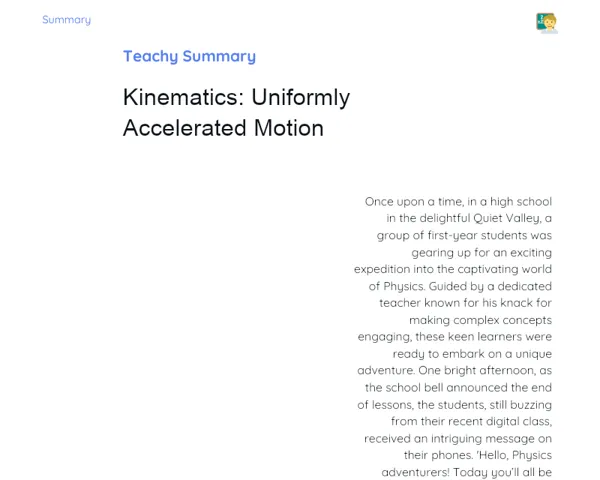Summary Tradisional | Kinematics: Oblique Motion Equation
Contextualization
Kinematics is an important branch of physics that deals with understanding the motion of objects without going into the reasons behind it. In our day-to-day life, we often see examples of projectile motion – be it a ball being thrown in a playground or the path taken by a rocket. This type of motion happens in two dimensions, which allows us to break it down into horizontal and vertical components.
Projectile motion is essentially a mix of two types of movement: uniform motion along the horizontal axis, where the speed remains constant, and uniformly accelerated motion along the vertical axis due to gravity. This breakdown is key to mathematically describing how an object moves through the air, and it finds practical applications in areas like sports and engineering.
To Remember!
Decomposition of Motion
In projectile motion, we can split the movement into two main parts: the horizontal component and the vertical component. The horizontal component follows uniform motion – that is, the speed stays the same and there is no acceleration. On the contrary, the vertical component is under the influence of gravity and shows uniformly accelerated motion.
This method of breaking down the motion is very useful because it allows us to apply the relevant equations for each part separately. For instance, for horizontal movement we stick to the simple equations of uniform motion to determine the position over time, while for the vertical movement, the equations of uniformly accelerated motion help us calculate position and speed.
Having a clear idea about this decomposition is essential for solving problems related to projectile motion, as it lets us predict the full trajectory of an object and compute key parameters like range and maximum height.
-
Projectile motion consists of both horizontal and vertical components.
-
The horizontal component follows uniform motion, while the vertical undergoes uniformly accelerated motion.
-
Breaking down the movement helps us apply the correct equations to each component.
Equations of Uniform and Uniformly Accelerated Motion
To mathematically describe projectile motion, we use two fundamental equations. The equation for uniform motion is given by S = S₀ + vt, where S represents the final position, S₀ is the initial position, v is the velocity, and t stands for time. This equation fits the horizontal part of the motion because the speed remains constant throughout.
On the other hand, for the vertical component, we use the equation of uniformly accelerated motion: S = S₀ + vt + 1/2at². Here, S again is the final position, S₀ is the starting position, v is the initial velocity, a denotes acceleration, and t is time. In this case, acceleration is provided by gravity (g ≈ 9.8 m/s²).
By using these equations, we can accurately describe the trajectory of an object. The first equation helps us track the horizontal position over time while the second deals with the vertical changes.
-
Uniform motion is represented by S = S₀ + vt.
-
Uniformly accelerated motion is given by S = S₀ + vt + 1/2at².
-
These equations target the horizontal and vertical components of projectile motion respectively.
Maximum Range and Maximum Height
The maximum range of a projectile is the furthest horizontal distance it travels. To compute this, we use the formula R = (v₀² * sin(2θ))/g, where v₀ is the initial velocity, θ is the launch angle, and g is the acceleration due to gravity. This formula takes into account how the initial velocity splits between the horizontal and vertical directions.
Similarly, the maximum height is the highest point that the projectile reaches during its flight. This is calculated using H = (v₀² * sin²(θ))/(2g). Again, the role of gravity and the vertical component of the initial velocity are central to this calculation.
Knowing how to calculate both the maximum range and height is very helpful when dealing with real-life projectile motion problems, be it in rocket science or in popular sports.
-
Maximum range is calculated using: R = (v₀² * sin(2θ))/g.
-
Maximum height is found by: H = (v₀² * sin²(θ))/(2g).
-
Such calculations are practical in various fields, including engineering and sports.
Problem Solving
When solving projectile motion problems, it is important to follow a systematic approach. First, break down the initial velocity into its horizontal and vertical parts. This is achieved using the cosine and sine of the launch angle: v₀x = v₀ * cos(θ) and v₀y = v₀ * sin(θ).
Then, apply the appropriate motion equations to determine positions and speeds over time. The horizontal component adheres to S = S₀ + vt, while for the vertical component, we use S = S₀ + vt + 1/2at² along with v = v₀ + at.
Lastly, you may need to calculate the maximum range and height using the mentioned formulas. Engaging in guided problem-solving helps cement these concepts and demonstrate the effective application of the equations in predicting the motion of projectiles.
-
Start by decomposing the initial velocity into horizontal and vertical components.
-
Use the respective equations for uniform and uniformly accelerated motion.
-
Compute the maximum range and maximum height as necessary.
Key Terms
-
Kinematics: The study of motion of objects without including the forces that cause it.
-
Projectile Motion: Motion occurring in two dimensions, decomposable into horizontal and vertical components.
-
Uniform Motion: Motion with constant speed and no acceleration.
-
Uniformly Accelerated Motion: Motion where speed changes under constant acceleration.
-
Decomposition of Motion: The division of projectile motion into horizontal and vertical components.
-
Maximum Range: The longest horizontal distance a projectile covers.
-
Maximum Height: The highest point attained by a projectile during its movement.
-
Initial Velocity: The speed at which an object is launched initially.
-
Acceleration due to Gravity: A constant acceleration of approximately 9.8 m/s² affecting the vertical motion.
Important Conclusions
In this lesson, we explored Kinematics with a special focus on projectile motion and its separation into horizontal and vertical components. The discussion clarified that, in projectile motion, the horizontal section experiences uniform motion while the vertical section experiences uniformly accelerated motion due to gravity. Essential equations such as S = S₀ + vt (for uniform motion) and S = S₀ + vt + 1/2at² (for uniformly accelerated motion) were introduced as key tools in analyzing each component.
Besides, we reviewed how to compute the maximum range (R) and maximum height (H) using the formulas R = (v₀² * sin(2θ))/g and H = (v₀² * sin²(θ))/(2g) respectively. These ideas not only strengthen our grasp of theoretical physics but also find their application in everyday scenarios like sports and engineering projects. The step-by-step problem-solving practice further reinforces the understanding and effective use of these equations.
This foundational knowledge is highly relevant for analysing common situations such as the trajectory of a cricket ball or the launch of a rocket. Students are encouraged to further investigate projectile motion, as it beautifully bridges theoretical principles with practical applications.
Study Tips
-
Revisit class notes and practice breaking down motions into horizontal and vertical components.
-
Solve additional exercises on projectile motion to gain better familiarity with the equations involved.
-
Explore real-life applications of projectile motion in fields like sports and engineering to appreciate its practical significance.



